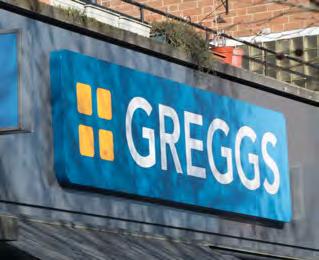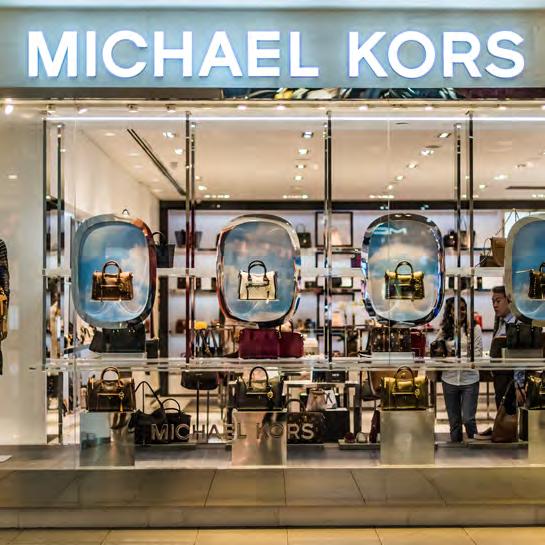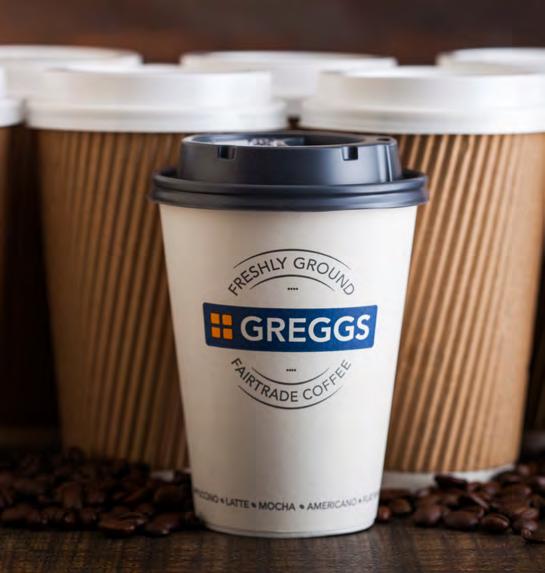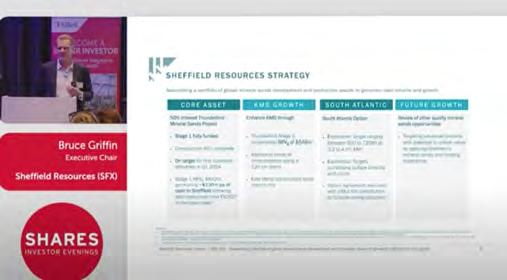FAVOURITE YOUR FUNDS
Are they reliant on just a few holdings for their returns?

VOL 25 / ISSUE 32 / 17 AUGUST 2023 / £4.49
Capital at risk.
That’s the sweet sound of taking control of your investments with AJ Bell.



06 NEWS
12
• Top fund managers continue to back the UK consumer amid record wage growth
• Two potential UK winners from the Tapestry-Capri luxury mega-merger

• Fresh ‘Spot The Dog’ research reveals big increase in funds failing to deliver for investors
• Big breakthroughs on obesity and Alzheimer’s make Eli Lilly world’s largest pharma firm
• Pod Point powers down but hopes change at the top can recharge the shares
GREAT IDEAS
New: Secure Trust Bank / AG Barr Updates: EMIS
18 FEATURE You favourite funds: Are they reliant on just a few holdings for their returns?
26 FEATURE Smith & Nephew management under big pressure to deliver on their promises

30 FEATURE How to analyse Greggs in five easy steps

36 EDITOR’S VIEW Watch out: Chinese real estate worries are stalking the market once again
37 PERSONAL FINANCE Lessons from a decade of AIM shares being allowed in an ISA

39 FEATURE Why investors in US shares may have to lower their growth expectations
41 ASK TOM Why do ex-pats in some countries see their state pension frozen when others don’t?
42 INDEX Shares, funds, ETFs and investment trusts in this issue

17 August 2023 | SHARES | 03 Contents 41
14 26 07
Three important things in this week’s magazine
FAVOURITE YOUR FUNDS
WtoTherecentdecisionbytheNasdaqstockexchange hasreducetheweightingofthebiggesttechstocks onceagainraisedthequestion,canyouhavetoomuchofagoodthing? Wedonotnecessarilymeantechstocks,but asaninvestoritisimportanttoknowhowmuch exposureyouhavetoeachareaofthemarket. trustsIntermsofdiversification,fundsandinvestments portfolio,canbeasmartwaytospreadriskinabutisitpossiblethatwithoutrealisingit partsyoucanstillendupwithmoreexposuretosome ofthemarketthanyoubargainedfor?



X-RAY YOUR PORTFOLIO toolsThegoodnewsishelpisathandintheformof likethe‘portfoliox-rayanalysis’,whichisfree forcustomersoffinancialservicesfirmAJBell,the ownerofSharesmagazine.

Are
software,The‘x-ray’tool,poweredbyMorningstar investmentsnotonlycalculatesthespreadofyour inindividualstocksbutcan‘lookinto’andtrusts,fundsandETFs(exchange-tradedfunds) holdingsworkoutyourexposurefromthelistoftheir togiveyouafullpicture. showingBelowisananalysisofatheoreticalportfolio boththeunderlyingsectorexposureas andwellasthestylistic‘tilt’towardscyclical,defensive economicallysensitivebusinesses. betweenInthiscase,theportfolioiswellbalanced underlyingdiversetypesofbusinesses,albeitthe sectorweightingsarevastlydifferent fromsaytheFTSE100ortheFTSEAll-Shareindex.

How reliant are your favourite funds on their top holdings
We examine concentration risk from a stock and sector point of view at some of the most popular UK investment products
Feature:AnalysingGreggs

Analysing Greggs

Five easy steps to understand the investment case behind the food-on-the-go leader encompassing like-for-like sales, profit, cash flow and valuation
Visit our website for more
articles
Did you know that we publish daily news stories on our website as bonus content? These articles do not appear in the magazine so make sure you keep abreast of market activities by visiting our website on a regular basis.


Over the past week we’ve written a variety of news stories online that do not appear in this magazine, including:
toWhyinvestorsinUSsharesmayhave lowertheirgrowthexpectations
operatingearningsgrowthoverthelast30years. afterFortheuninitiated,netincomeiscalculated operatingdeductinginterestexpensesandtaxesfrom andSmolyanskyprofit.pointsoutthatinterestexpenses taxeshavedeclinedprecipitouslyasashare inofoperatingincomefrom54%in1989tojust27% ‘Golden2019.Theeconomistmakesthecasethatthe Era’isunlikelytoberepeatedoverthenext30years. halveTheimplicationisthatnetprofitgrowthcould towardsoverthecomingdecadesmovingback thelong-termoperatingincomegrowthaverageof2%.
theThebigdeclineinofficialinterestratessince 1980shascoincidedwithacommensurate fallincorporateborrowingcosts.Theaggregate 12%corporaterateofinterestexpensehasfallenfrom in1982toaround3%accordingtoCompustatwouldWithinflationprovingstickierthantheFed aroundlike,current10-yeartreasuryyieldsof Economist4%couldremainelevatedforsometime. MohamadA.El-Erianarguesthat structuralchangestoglobalsupplychainsbrought implyaboutbythepandemicandthewarinUkraine build-inhighercoreinflationasglobalbusinesses moreoperationalflexibilityandcosts.This
andCorporatetaxratesaveraged44%between1962 term1982.BytheendofRonaldReagan’ssecond corporateasPresidentin1989theeffectiverateof taxhaddeclinedby10%to34%. thePassingoftheJobsCutsandTaxActof2017saw whichratedeclinefurtherfrom23%to15%in2019 mayproveafloorarguesSmolyansky. TheInflationReductionActof2022made15% overaminimumwhileahugeincreaseintheUSdeficit thelastthreeyearsmeansCongressisunlikelytoapprovefurtherdebt-fundedtaxcuts. FitchSupportingtheargument,creditratingagency downgradedtheUSsovereigncreditratingfromtripleAon2August. accustomedThebottomlineisthatinvestorshavebecome toarateofnetincomegrowthwhich looksextremelydifficulttorepeat.Meanwhilethe trailingPE(pricetoearnings)ratiofortheS&P500 itexcludingfinancialsdoubledbetween1989,when evenstoodat11.8times,to20.3timesby2019andis moreelevatedtoday.
Investors in US stocks may have to lower expectations
A long-running tailwind from lower borrowing costs and falling taxes may be about to reverse
04 | SHARES | 17 August 2023 Contents
1
3
2
28 SHARES 17August2023 HavinganalysedMicrosoft(MSFT:NASDAQ)andUnilever(ULVR)in partsoneandtwo partthreeofSharesnewmini-seriesisanexamination ofthekeymetricsandinvestmentmeritsof Greggs(GRG).Amoredown-to-earthchoicebut unquestionablyoneoftheUK’sfavouriteoptions forfoodonthego,nowguidedbyCEORoisin Currie. ANALYSINGGREGGS Wewilldigintothenumbersatthevaluefor-moneysausagerolls,coffeesandsweet stocktreatssellerwithTynesideorigins.Thisisa (capitalthathasservedupatastytotalreturn growthplusdividends)sincejoiningthe instockmarketasahumblebakeryretailerback To1984.recap,theaimwiththismini-seriesis toprovideyouwithaneasy-to-usefivestep mostframeworkwhichcanbeappliedtomanyofthe populartypesofcompany.Thisfeature shouldgivereadersabetterunderstandingofthe iconicperformancedriversatthecompanybehindthe whethervegansausageroll,andsomeideaasto itsstunningsuccessissustainableintothefuture. STEP ANALYSINGONESALES GROWTHGreggssales 2022 £1.51bn 17.8% 2021 £1.23bn 52.4% 2020 £811.3m −36.2% 2019 £1.17bn 9.2% 2018 £1bn 2.9% 2017 £960m 3.7% 2016 £894.2m 4.2% 2015 £835.7m 4.7% 2014 £806.10 4.5% 2013 £762.40 −0.8% Year Total sales Like-for-likesalesgrowth Table:Sharesmagazine•Source:Annualreports,companyaccounts WelookattheinvestmentmeritsoftheTyneside-basedfood-on-the-gostarturn HowtoanalyseGreggsinfive easysteps Feature:USstockmarket 17August2023 SHARES 37 Itmaybehardtojustifythemarket’sloftyvaluationsformuchlongerWithinvestors’fixedattention inflationonand interestratesaneconomist arguesattheUSFederalReserve prepareinvestorsshould themselvesfora sharpdropinnetincome growthovercoming decades.Anewresearchpaperby onMichaelSmolyanskybased datafromCompustat
showsthatnetincomehas grownat3.8%ayear,roughlydoublethe2%rateof
ByMartin Gamble EducationEditor US interest rate 198019902000 20102020 0 10 15% Chart:Sharesmagazine•Source:Refinitiv 16 SHARES | 17August2023
ByIanConwayCompaniesEditor
they reliant on just a few holdings for their returns?
What to expect from technology picks and shovels giant Cisco in Q4
YouGov mulling US listing another blow for London stock market
Krispy Kreme shares fall nearly 14% despite positive second quarter earnings
Directors deals: Babcock boss sells £298,000 shares while Mitie chief’s purchase signals confidence
BECOME A BETTER INVESTOR WITH
SHARES MAGAZINE HELPS YOU TO:
• Learn how the markets work
• Discover new investment opportunities

• Monitor stocks with watchlists
• Explore sectors and themes

• Spot interesting funds and investment trusts
• Build and manage portfolios
Top fund managers continue to back the UK consumer amid record wage growth
Recent indicators suggest the UK could avoid a

Recent weeks have seen a couple of encouraging economic data points for investors betting on the resilience of the UK consumer.
Second-quarter GDP (gross domestic product) grew at a faster rate than expected, even as interest rates have risen, pushing up mortgage costs on top of rising food and energy bills.
Wage growth also surprised to the upside at 8.2% in the second quarter, a new record and well above the Bank of England’s forecast of 7.6%, although the unemployment rate crept up to 4.2% as the labour market starts to slacken. The wage growth number led to market volatility as it prompted fears inflation is becoming more entrenched, forcing the Bank to take a harder line on rates.
Meanwhile, despite the travails of Wilko, which were mostly self-inflicted, homewares
seem to be enjoying a revival in sales even if the weather in July meant footfall on the high street was disappointing.
In an unsheduled trading update, Marks & Spencer (MKS) reported a 6% increase in like-forlike sales in its clothing and home division in the 19 weeks to 12 August, while homewares producer UP Global Sourcing (UPGS) posted a 15% increase in sales in the six months to 31 July, despite not raising prices, with online sales booming.
Mark Barnett, fund manager at Tellworth Investments, began increasing his exposure to consumer stocks in September 2022 on the basis valuations were ‘far too low’ and spending looked like holding up.
‘Despite much press commentary highlighting the wage squeeze combined with the pessimistic forecasts from the Bank of England and the IMF, the UK consumer has continued to spend and, actually is fundamentally in pretty good shape with strong cash balances, low levels of debt and, high levels of employment’ says Barnett.
‘These buffers have provided a cushion against the recent shocks and will act as a springboard for the eventual recovery. As I expect headline inflation to ease over the course of 2023, some growth in real wages is to be expected which in turn will fund increases in consumption and GDP.’
Barnett’s holdings include Dunelm (DNLM), Howden (HWDN), Next (NXT) and Whitbread (WTB).
Ken Wotton, managing director of public equities at Gresham House, agrees: ‘Concerns about the UK economy and understandable worries about the outlook for consumer discretionary spending in the face of inflation and increasing interest rates have driven consumer stocks to almost unprecedented lows.
Low ticket value-for-money experiential leisure and some areas of e-commerce look particularly good value.’
Wotton’s holdings include Angling Direct (ANG:AIM), Moonpig (MOON) and Ten Entertainment (TEG). [IC]
News 06 | SHARES | 17 August 2023
2023 recession but wage growth surprise revives interest rate fears
Average weekly earnings annual growth rates in Great Britain, seasonally adjusted, January to March 2001 to April to June 2023 Jan to Mar 2001Jul to Sep 2010Jan to Mar 2020 −4 −2 0 2 4 6 8 Total pay (nominal) Regular pay (nominal) Total pay (real) Regular pay (real) Chart: Shares magazine•Source: Office for National Statistics
Two potential UK winners from the Tapestry-Capri luxury mega-merger
Whether the US combination can disrupt the dominance of European conglomerates is debatable
Coach, Kate Spade and Stuart Weitzman brands owner Tapestry (TPR:NYSE) has agreed to buy Versace, Michael Kors and Jimmy Choo parent Capri (CPRI:NYSE) in an $8.5 billion (£6.7 billion) tie-up between the two American fashion houses.
Slated to close by the end of 2024, the megamerger should create a stronger rival for the likes of Burberry (BRBY) and is an attempt to better compete with European luxury conglomerates including LVMH (MC:EPA), Hermès (RMS:EPA), Kering (KER:EPA) and Richemont (CFR:SWX).

Whether Tapestry’s purchase of Capri can creates a serious rival to LVMH is questionable however, judging by the plunge in the share price since the deal was announced (10 August).
Though the timing of the merger seems counterintuitive given recent worries over luxury spending in the US and China, the deal may have merit on a long-term view. Both businesses are looking to overseas markets to help boost growth and according to Tapestry and Capri, the combined business will consist of ‘six highly complementary brands with global reach’.
Interestingly, Shore Capital highlights the enlarged company’s strategic focus on the entry level of the luxury space. And the broker believes this strategic positioning could ‘potentially create a unique value proposition, appealing to a broader consumer base that aspires to enter the world of luxury brands without the exclusivity and high price tags associated with traditional luxury names’.
Tapestry’s approach to targeting the entry level of luxury could disrupt the large European players by offering this wider customer base ‘a blend of American style and accessibility’. And with inflation cooling stateside, the new entity could ‘potentially benefit from a more stable economic
environment, allowing it to focus on expanding its market presence and leveraging the appeal of affordable luxury,’ says the broker.
Shore Capital highlights two UK retailers with ‘strategic alignment with emerging trends in the luxury sector,’ namely high-end timepieces and jewellery purveyor Watches of Switzerland (WOSG) and Mike Ashley-controlled Frasers (FRAS), the FTSE 100 conglomerate behind Flannels and House of Fraser besides Sports Direct.

According to analysts Eleonora Dani and Clive Black, Watches of Switzerland’s robust sales growth in the US in a tougher first quarter to 30 July 2023 underscores the Rolex retailer’s ‘momentum and the aspirational nature of luxury timepieces’. Black and Dani also stress that Frasers could stand to gain from Tapestry’s strategy of focusing on the entry level of luxury.
‘A stronger entry-level offer aligns with Frasers’ Flannels stores’ positioning, potentially drawing more footfall and enhancing the overall shopping experience.’ [JC]
News 17 August 2023 | SHARES | 07
Fresh ‘Spot The Dog’ research reveals big increase in funds failing to deliver for investors
The Global sector saw the highest number of dog funds overall
Newly published research names and shames the funds which have failed to deliver for investors over three consecutive 12-month periods.
The latest ‘Spot The Dog’ report has identified 56 equity funds as serious and persistent underperformers – a 27% increase on 44 dog funds exposed in the last report in January 2023. The amount of assets held in dog funds has more
than doubled from £19.1 billion in the last report to £46.2 billion.
St James’s Place (STJ) dominates with six entries and no single fund manager came close to the wealth manager, which accounted 63% of the overall assets in dog funds. However, Artemis also holds £2.66 billion in dog funds, Scottish Widows has £2.1 billion, Columbia Threadneedle £1.92 billion and Abrdn (ABDN) £1.67 billion.
Selection of Spot The Dog underperforming funds
‘If there is a theme across the companies and strategies that have struggled, it is a quality bias. This has been a tough area of the market over the past three years, having fallen between the cracks of the various rotations between growth and value,’ noted the report, which is produced by Bestinvest.
The Global sector saw the highest number of dog funds overall, with 24 relegated to the doghouse, up from just 11 funds last time, representing 15% of overall assets in the sector.
There are a few funds, however, which have ‘turned the corner’ since the last report and avoid the list this time round. Invesco has overcome problems with its UK equity franchise, for example, and Fidelity American (B8GPC42) has also improved its showing. Japan, Smaller Companies and Emerging Markets are fund sectors with just one or two dogs, suggesting active fund managers can often do best in the less widely followed parts of the market. There were also no Global Equity Income funds on the list this year. [SG]

News 08 | SHARES | 17 August 2023
1 St. James’s Place Global Quality Global 11.47114 −24% 2 St. James’s Place Global Growth Global 7.49 109 −28% 3 St. James’s Place International Equity Global 7.09101 −36% 4 St. James’s Place Growth European Progress Europe Excluding UK 1.85 113 −17% 5 Scottish Widows UK Growth UK All Companies 1.82120 −14% 6 Artemis US Select North America 1.53 125 −17% 7 Columbia Threadneedle Responsible Global Equity Global 1.41120 −17% 8 abrdn UK Smaller Companies UK Smaller Companies 1.11 90 −18% 9 Troy Asset Management Trojan Income UK All Companies 1.00105 −29% 10 St. James’s Global Emerging Market Global Emerging Markets 0.87 85 −20% Fund IA Sector Size (£bn) Value of £100 invested after 3 years Three-year under performance (%) Table:
•
Shares magazine
Source: Spot The Dog, Bestinvest August 2023
Big breakthroughs on obesity and Alzheimer’s make Eli Lilly world’s largest pharma firm
Shares are up more than 70% over the last 12 months as two new treatments capture market’s imagination
Shares in pharmaceutical giant Eli Lilly (LLY:NYSE) have put in an outstanding performance over the last 12 months rising 71.4% to the $539 mark to become the world’s largest drugmaker by market value.
Much of the excitement around the stock has been driven by new treatments for two of the globe’s biggest public health issues in obesity
and Alzheimer’s. The company announced results in July from a late-stage trial showing its Alzheimer’s treatment Donanemab had a big impact on memory loss and cognitive decline.

Diabetes and weight loss treatment Mounjaro is also capturing the market’s imagination. Having been approved to treat diabetes in 2022, a trial in April revealed it also cut body weight significantly and it is expected to be greenlit as an obesity treatment later in the year.
Momentum has been
Pod Point powers down but hopes change at the top can recharge the shares
Company has fallen more than 80% on its 2021 IPO price and is down 45% year-to-date
There was some excitement when EV (electric vehicle) charging play Pod Point (PODP) joined the stock market in 2021.
At the time Shares expressed concerns about a lofty valuation, limited visibility on its road to profit and a competitive marketplace. These reservations have proved to be prescient despite its leading 15% market share in home
EV charging units.

Pod Point will hope a change of leadership can prompt a change of fortunes after seeing its shares career lower from the 225p IPO price to just 35p today. In July founder Erik Fairbairn was replaced at the top on an interim basis by former Aston Martin Lagonda (AML) CEO Andy Palmer, who had previously served as the company’s senior
sustained by its recent secondquarter results. On 8 August, the company raised its full-year revenue guidance to between $33.4 billion and $33.9 billion, up from the previous forecast of $31.2 billion to £31.7 billion.
The company posted an 85% jump in second-quarter earnings year-on-year in part supported by strong sales in breast cancer pill Verzenio and type-two diabetes drug Jardiance. [SG]
Results for the six months to 30 June (31 July) suggested the company is no closer to achieving profitability. Pod Point posted a drop in revenue of 26% to £30.6 million and saw its net loss widen by 337% to £33 million with cash on the balance sheet falling from £74.1 million at the start of 2023 to £58.8 million. A planned investor day in the fourth quarter looks like a crunch moment. [TS]
News 17 August 2023 | SHARES | 09
Eli Lilly ($) Oct 2022 Jan 2023 AprJul 300 350 400 450 500 Chart: Shares magazine•Source: Refinitiv Pod Point (p) Jan 2022 AprJulOctJan 2023 AprJul 0 50 100 150 200 250 Chart: Shares magazine•Source: Refinitiv independent director.
DOWN in the dumps HIGHER Moving
UK UPDATES OVER THE NEXT 7 DAYS
FULL-YEAR RESULTS
August 24: Cropper (James)
HALF-YEAR RESULTS
August 22: Wood Group, Empresaria, Anexo
August 24: Macfarlane, CRH, Hunting, Tribal
Wood Group needs to show big progress after collapse of Apollo deal
TRADING ANNOUNCEMENTS
August 22: RUA Life
Energy services firm Wood Group (WG.) is under pressure to deliver after ultimately unrealised takeover interest from private equity firm Apollo Global Management earlier this year.
In May Apollo said it would not proceed with a takeover, despite Wood finally opening its books to the firm at the fifth time of asking in response to a bid of 240p per share. With no reasoning given for Apollo’s stance, it’s no surprise investor confidence was shaken.

Having collapsed, the stock has recovered some ground but still trades substantially below this bid price at 164.9p.

The company has been beset by restructuring and legacy issues since its 2017 merger with Amec Foster Wheeler, such that,

despite some underlying progress, Berenberg does not anticipate positive free cash flow until 2024. Cash flow and margin performance will likely be in focus when the company reports its results for the six-month period ended 30 June on 22 August.
Management may also be expected to provide some colour on a recent multi-year framework agreement struck with Shell (SHEL) to continue providing services on the energy giant’s global projects. No financial terms have been disclosed on the three-year agreement which has options for two one-year extensions. [TS]
News: Week Ahead 10 | SHARES | 17 August 2023
Private equity firm walked away from a £1.6 billion bid in May
What the market
of Wood Group Forecast for 2023 12.45.7 Forecast for 2024 17.9 6.1 EPS (p) Revenue (£bn) Table: Shares magazine Source: Stockopedia Wood Group (p) Oct 2022 Jan 2023 AprJul 100 120 140 160 180 200 220 Chart: Shares magazine•Source: Refinitiv
expects
Nvidia earnings report will determine if its superb run can continue
US UPDATES OVER
THE NEXT 7 DAYS
QUARTERLY RESULTS
August 18: Deere & Company, Palo Alto Networks, Estee Lauder

but have stalled in recent weeks
The rapid acceleration in the AI (artificial intelligence) story has lit a fire under the shares of semiconductor designer Nvidia (NVDA:NASDAQ) in 2023, making it among the best performers on the US market.

However, in recent weeks the stock has stalled and its near-term trajectory is likely to be dictated by second quarter earnings out on 23 August.
Nvidia stands to benefit from the development of AI because its chips are used to develop machine learning software. The company calls its DGX system an ‘AI supercomputer’ and ‘the blueprint of AI factories’ being built across the globe.
As major tech companies invest heavily in AI, this will be expected
to translate into significant earnings growth for Nvidia.
For the year to January 2024 EPS (earnings per share) is expected to more than treble to $7.94 and for the three-month quarter just gone, $2.06 is anticipated on revenue of $11.1 billion.
In the first quarter Nvidia handily beat estimates, with EPS of $1.09 versus the forecast $0.92 on revenue of $7.19 billion against the anticipated $6.5 billion. The one big weak spot was the gaming division which was hit by the weaker macroeconomic backdrop. [TS]
August 21: Nordson
August 22: Lowe’s, Medtronic, Zoom Video
August 23: Nvidia, Salesforce, Analog Devices, Autodesk, NetApp, Bath & Body Works, Advance Auto Parts
August 24: Intuit, PDD Holdings, Workday, Dollar Tree, Ulta Beauty, JM Smucker

News: Week Ahead 17 August 2023 | SHARES | 11
Shares are up more than 180% year-to-date
What the market expects of Nvidia Q2 forecast 2.0611.10 EPS ($) Revenue ($bn) Table: Shares magazine•Source: Yahoo Finance Nvidia ($) Oct 2022 Jan 2023 AprJul 100 200 300 400 Chart: Shares magazine•Source: Refinitiv
Irn-Bru maker AG Barr deserves more credit for its sales momentum
alternatives – and Boost, the profitable energy, sport, iced coffee and protein drinks company.
AG Barr’s world-class manufacturing sites, considerable marketing clout, track record of generating high returns on capital and net cash balance sheet represent a cocktail of competitive strengths.
Price: 484.5p
Market cap: £547.3 million
Investors seeking a high-quality pick in the beverages sector should buy AG Barr (BAG), the Irn-Bru and Rubicon drinks maker that deserves more credit for delivering positive sales momentum despite headwinds from the inflation squeezing consumers’ spending power and its own operating margins.

The FTSE 250 company offers scope for further forecast upgrades due its demonstrably strong brand momentum and with commodity costs in decline. Considered one of the soft drinks industry’s best operators, canny CEO Roger White will retire in the next 12 months after a long and successful tenure at AG Barr.
He leaves the business in great shape, having transformed the company from a regional soft drinks maker into a branded multi-beverage business that is strategically well-placed for growth. Recent downpours won’t have helped the soft drinks maker’s sales of late, but the incoming heatwave forecast at the time of writing should provide a boost.
For the uninitiated, AG Barr manufactures market-leading UK drinks brands including iconic Scottish tipple Irn-Bru as well as the Rubicon, Barr and Tizer fizzy drinks and take home cocktail offering FUNKIN. AG Barr has also increased its exposure to high-growth categories through the acquisitions of challenger oat milk maker MOMA Foods – oat milk is outperforming other plant-based
The £547.3 million cap recently (1 August) upgraded pre-tax profit guidance for the year to January 2024, now seen coming in ‘marginally above the top end’ of analyst expectations.
This upwards earnings revision reflected positive trading across the company’s soft drinks divisions in the half to July as well as the removal of the cost and uncertainty of the now delayed Scottish deposit return scheme and high hopes for a number of brand launches planned for the second half.
On Shore Capital’s current year estimates, AG Barr trades on a forward multiple of 15.2, well below the 10-year average and grudging given the group’s defensiveness and earnings growth potential. The shares also offer a near-3% yield based on Shore’s 13.7p current year dividend forecast.
Liberum Capital sees ‘significant potential for growth and margin expansion’ once the transitionary impacts of inflation pass, which should drive ‘significant earnings growth and a rerating’ of the stock. [JC]
Great Ideas: Investments to make today 12 | SHARES | 17 August 2023
The Irn-Bru, Rubicon and Boost drinks maker is strategically well-placed for growth
(p) 20192020202120222023 400 600 800 Chart: Shares magazine•Source: Refinitiv
AG Barr
AG Barr (BAG)
Secure Trust Bank is cashing in helping consumers get what they want
and retail partners across the UK, helping shoppers buy the things they want.
In the first half of this year, the bank grew its retail loan book by 12% or £614 million and increased its market share to 12.9% from 11.4% six months earlier.
Secure Trust Bank
(STB)
Price: 662p
Market cap: £127 million
Investors who are risk-averse and prefer to avoid small-cap stocks may want to stop reading here, but for those with a nose for value and an appetite for contrarianism we think there is a lot to like about specialist lender Secure Trust Bank

(STB).
To say the stock is unloved is an understatement, as one look at the share price performance over the last five years demonstrates.
Secure Trust Bank provides retail finance and vehicle finance for consumers as well as property and commercial finance.
Its retail finance arm arranges and administers finance and loans for well-known national brands
Secure Trust Bank
In vehicle finance its V12 ‘product hub’ allows dealers to buy, sell and finance used vehicles, while its Moneyway finance arm has hundreds of thousands of happy customers across the UK.
Lending increased by 18% or £250 million in the first half as the used car market soared and the bank grew its dealer and broker relationships.
The real estate finance business offers loans to experienced developers of residential and commercial schemes as well as professional landlords, and grew its loan book by 10% or £250 million in the first half, while commercial lending was flat as the bank made a strategic shift towards lower-yielding but lower-risk financing.
On the whole, therefore, the bank increased its loan book in three of four of its large addressable markets while staying disciplined in terms of risk, and reported a net interest margin of 5.4%, which the high-street giants would kill for given they are expecting to report an average margin of just 1.5% this year.
Even though it took an impairment charge of £7.2 million for non-recoverable loans in the first half, which management says is unique and relates to a long-standing commercial debt, pre-tax profit of £16.5 million was almost flat implying underlying earnings grew by 15%.
With no write-offs in the second half, profits are expected to increase ‘significantly’ thanks to loan book growth and a low cost-to-income ratio.
So why does STB trade on 0.4 times 2023 book value, 3.6 times earnings and a dividend yield of 7.5% with the dividend four times covered?
‘The market is valuing the shares as though the company has serious balance sheet issues, which we do not agree with’, says Shore Capital. We can only concur. [IC]
Great Ideas: Investments to make today 17 August 2023 | SHARES | 13
(p) 20192020202120222023 500 1,000 1,500 Chart: Shares magazine•Source: Refinitiv
Despite its strengths this specialist lender remains deeply unloved and undervalued
Watchdog U-turn leads to quickfire EMIS profit of 39%
(EMIS:AIM) £19.08
39%
Readers who backed our recent arbitrage call on EMIS (EMIS:AIM) should be feeling pretty chuffed having banked a rough 39% in five weeks, and we called it spot on.
We said at the time (6 Jul) that this investment pitch was ‘a little different to the sort of investment ideas Shares typically presents to readers,’ but having paid-off much like we said it might, what should shareholders do now?
WHAT HAS HAPPENED SINCE WE SAID TO BUY?
First, let’s recap. NHS technology platform supplier EMIS provides vital technology to the UK’s thousands of GP practices and millions of NHS users. A £1.2 billion takeover offer from US peer UnitedHealth (UNH:NYSE) was agreed more than a year ago, but the deal was put under investigation by the UK’s Competition and Markets Authority.
EMIS is estimated to hold a UK market share of more than 50% in electronic patient records through its EMIS Web platform. The company currently integrates with several third-party systems but doing so in the future could be seeding business to rivals of Optum, UnitedHealth’s UK arm.

Now the CMA has changed its mind about competition concerns in a late volte-face, largely because it thinks the NHS will be able to use its oversight role to prevent the merged business from harming the competitiveness of rivals.
Megabuyte analyst Ieuan Turner says: ‘Remarkably, no disposals have been deemed necessary as it all stems down to the oversight role that the NHS holds in the UK healthcare market.’
WHAT SHOULD INVESTORS DO NOW?
The CMA will conduct a public consultation on the provisional findings before it releases its final report, scheduled for October 2023, but the stock has surged, to £19.08.
That modest discount to the £19.25 agreed cash takeover price suggests some marginal doubts over the deal remain, although a spanner being thrown into the works looks very unlikely. Still, why take any risk at all?
Shares believes you’re better off closing the trade now, banking your 39% profit (less costs) and moving on to something else. [SF]
Great Ideas Updates 14 | SHARES | 17 August 2023
EMIS
Gain to date:
Time to sell after healthcare tech takeover greenlit and stock jumps EMIS Oct 2022 Jan 2023 AprJul 1400 1500 1600 1700 1800 1900 Chart: Shares magazine•Source: Refinitiv
Japanese shares have hit 33-year highs – but why?

With Japanese stocks scaling heights not seen since 1989, we look at what’s driving them, explain why the Tokyo Stock Exchange has called on companies to enhance their corporate value and what this may mean for investors in the Schroder Japan Trust plc.
Japanese shares are flourishing so far in 2023. In recent months, the major equity indices, the Topix and the Nikkei 225, both hit their highest levels since 1989.
Gains for Japanese equities have outpaced other developed markets, albeit the weaker yen has reduced those gains for overseas investors, such as shareholders of Schroder Japan Trust, which is denominated in UK sterling.

What’s behind this growing enthusiasm for
Japanese shares? We think there were two key factors driving this momentum.
One is a cyclical aspect, with the Japanese economy
ADVERTISING FEATURE
being relatively late to reopen after the Covid-19 pandemic. This gives confidence in corporate earnings growth this year, alongside attractive valuations as a whole for the Japanese stock market.
Secondly, and this is more important as a structural development for the long term, the trigger was the Tokyo Stock Exchange (TSE)’s call earlier in 2023 for companies to focus on achieving sustainable growth and enhancing corporate value. This call was particularly directed at companies with a price-to-book ratio (P/B ratio) of below one.
The price-to-book ratio (P/B ratio) is a financial metric that compares a company’s stock price to its book value per share. The book value per share represents the company’s assets minus its liabilities, divided by the number of outstanding shares. If a company’s P/B ratio is below one, the market is valuing the company at less than its assets are worth.
There are many ways companies can try to improve their P/B ratio. The request to companies from TSE specifically mentions steps such as “pushing forward initiatives such as investment in research & development and human capital that leads to the creation of intellectual property and intangible assets that contribute to sustainable growth, investment in equipment and facilities, and business portfolio restructuring”. Another method is to increase returns to shareholders, either via dividends or buybacks (whereby the company repurchases its own shares).
REOPENING POST-COVID IS ALSO BOOSTING JAPANESE SHARES
Japan was under some form of pandemic restrictions for much longer than the US or Europe. The country only reopened its borders to foreign tourists in October 2022. Domestic travel is also recovering. We think this can help benefit smaller, domestically-focused companies operating in sectors such as travel, leisure, and hospitality.
Another important point is that China’s lifting of pandemic restrictions was even later than Japan’s. Trade with China is important for Japanese companies, and Chinese tourists were a sizeable proportion of total visitors to Japan (making up a third of the total in 2019). China’s belated post-Covid reopening is another positive influence for Japanese shares this year.
WELCOME RETURN OF INFLATION
After three decades of low inflation, and even deflation, the current return of mild inflation is very welcome in Japan. Deflation leads companies and consumers to delay investment and put off purchases; there’s little point buying something now if it will be cheaper tomorrow. By contrast, moderate inflation gives companies the confidence to invest for the future, and also spurs consumers to spend.
Rather than facing a downward deflationary spiral, Japan may now be entering a sustained period of higher corporate investment, wage growth, and increased consumer spending.

The challenge for consumers will be whether wages keep pace with this higher inflation, otherwise their purchasing power will be eroded. There were, however, positive signs from this year’s spring wage negotiations, with major firms agreeing a near 4% pay rise for employees, the highest pace over the last 30 years. This only affects a limited number of companies but is still encouraging because companies need to be confident about the business outlook if they are going to commit to pay rises.
Another factor is that, even after the rally so far this year, Japanese shares look attractively valued when compared to their own history and to other regional equity markets making it an attractive hunting ground for foreign investors.
SMALL CAPS POISED TO BENEFIT
We would highlight small companies in particular as the likely winners. This is partly because of their exposure to domestic services sectors that will benefit from reopening.
The unwinding of pandemic investment trends is also a factor. The uncertainty caused by the pandemic tended to see equity investors retreat to the safety of larger companies. However, the improved economic backdrop and renewed investor enthusiasm for Japan will bring higher liquidity, which is beneficial for smaller companies as it makes them easier to trade.
An existing valuation gap has widened of late, given the fact that Japan’s recent rally was very much driven by large cap stocks. This was mainly
IMPORTANT INFORMATION
This is a marketing communication.
Past performance is not a guide to future performance and may not be repeated. The value of investments and the income from them may go down as well as up and investors may not get back the amounts originally invested.
The material is not intended to provide, and should not be relied on for, accounting, legal or tax advice, or investment recommendations. Reliance should not be placed on any views or information in the material when taking individual investment and/or strategic decisions.
Any reference to sectors/countries/stocks/securities are for illustrative purposes only and not a recommendation to buy or sell any financial instrument/securities or adopt any investment strategy.
due to overseas investors buying index futures and liquid large cap stocks. Smaller companies remain attractively undervalued.
WHAT DOES THIS MEAN FOR SHAREHOLDERS OF THE SCHRODER JAPAN TRUST?
We believe the environment described above is very positive for shareholders in the Schroder Japan Trust. Indeed, it should be positive for all shareholders in Japan because the TSE’s recent focus on enhancing corporate value should ultimately deliver higher returns from Japanese businesses. In turn, after decades of dwindling international demand, this should generate more interest in Japan from global investors.
In particular, the Schroder Japan Trust portfolio is well-placed to benefit from these long-term trends, because of its focus on smaller companies and those sectors which are poised to most benefit from the return of inflation and the end of covid restrictions. Meanwhile, our focus on investing in attractively valued businesses, where the opportunity for improved returns and valuations is greatest, is also potentially meaningfully beneficial for shareholders.
All in all, we think the mix of short-term cyclical factors, plus long-term structural changes, adds up to an encouraging outlook for the Schroder Japan Trust and Japanese shares.
Click here to find out more about the Schroder Japan Trust
Information herein is believed to be reliable but Schroders does not warrant its completeness or accuracy.
For help in understanding any terms used, please visit www.schroders.com/en/insights/invest-iq/investiq/ education-hub/glossary/
We recommend you seek financial advice from an Independent Adviser before making an investment decision. If you don’t already have an Adviser, you can find one at www.unbiased.co.uk or www.vouchedfor.co.uk
Before investing in an Investment Trust, refer to the prospectus, the latest Key Information Document (KID) and Key Features Document (KFD) at www.schroders.co.uk/investor or on request.
Issued by Schroder Unit Trusts Limited, 1 London Wall Place, London EC2Y 5AU. Registration No 4191730 England. Authorised and regulated
Conduct Authority.
by the Financial
FAVOURITE YOUR FUNDS
We have touched before on the issue of ‘concentration risk’ or having too many eggs in one basket and the benefits of a diversified portfolio. The recent decision by the Nasdaq stock exchange to reduce the weighting of the biggest tech stocks has once again raised the question, can you have too much of a good thing?

We do not necessarily mean tech stocks, but as an investor it is important to know how much exposure you have to each area of the market. In terms of diversification, funds and investments trusts can be a smart way to spread risk in a portfolio, but is it possible that without realising it you can still end up with more exposure to some parts of the market than you bargained for?
X-RAY YOUR PORTFOLIO
The good news is help is at hand in the form of tools like the ‘portfolio x-ray analysis’, which is free for customers of financial services firm AJ Bell, the owner of Shares magazine.

Are they reliant on just a few holdings for their returns?
By Ian Conway Companies Editor
The ‘x-ray’ tool, powered by Morningstar software, not only calculates the spread of your investments in individual stocks but can ‘look into’ trusts, funds and ETFs (exchange-traded funds) and work out your exposure from the list of their holdings to give you a full picture.
Below is an analysis of a theoretical portfolio showing both the underlying sector exposure as well as the stylistic ‘tilt’ towards cyclical, defensive and economically sensitive businesses.
In this case, the portfolio is well balanced between diverse types of businesses, albeit the underlying sector weightings are vastly different from say the FTSE 100 or the FTSE All-Share index.
18 | SHARES | 17 August 2023
AJ BELL PORTFOLIO X-RAY ANALYSIS
Example portfolio

Defensive (37.8%) Cyclical (28.9%) Sensitive (33.3%) Chart: Shares magazine•Source: AJ Bell, Shares Cyclical Basic Materials 8.1% Consumer cyclical 7.8% Real estate 6.7% Financial services 6.3% Sector Weighting Sensitive Technology 18.3% Energy 6.8% Industrials 4.3% Communications 3.9% Sector Weighting Defensive Consumer defensive 24.2% Health care 10.4% Utilities 3.2% Sector Weighting 17 August 2023 | SHARES | 19
TOP MANAGERS MAKE BIG BETS
As American market guru and writer Howard Marks often reminds us in his investor letters, if you want to beat the market you have to do something different to the market.
As investors it is our job ‘to intelligently bear risk for profit - doing it well is what separates the best from the rest,’ says Marks.
Taking concentrated bets – and by association greater risk – is one way to generate better returns than the market, assuming you can identify great companies and buy them well.
If we look at Fundsmith Equity (B41YBW71), one of the largest and most widely owned funds among retail investors, the portfolio is made up of just 26 holdings with a strong bias towards consumer stocks and healthcare, and little exposure to technology or financial companies.
Fundsmith Equity
Fundsmith Equity
The firm lists its top 10 stocks on its website but does not reveal their weightings or tell us how much of the portfolio they make up, just that they are ‘high quality, resilient, global growth companies that are good value and which we intend to hold for a long time’.
However, Morningstar reports that as of the end of May the top five holdings – Microsoft (MSFT:NASDAQ), Novo Nordisk (NOVO-B:CPH), L’Oréal (OR:EPA), LVMH (MS:EPA) and Philip Morris International (PM:NYSE) – accounted for

Fundsmith Equity - Top Stocks
exactly a third of the portfolio, so it would seem a reasonable guess that the top 10 account for more than half the fund.
This level of concentration takes a lot of skill on the part of the managers and a lot of faith on the part of investors, but yet again Terry Smith has shown he knows his onions as his second-largest holding, Danish drugmaker Novo Nordisk, has rocketed recently following positive trial data for its Wegovy obesity treatment.
Just as important as knowing which individual stocks drive returns, investors should understand the sector weightings in the funds they own, which is easy enough as most provide a breakdown in their monthly fact sheets.
In the case of Fundsmith Equity, its sector exposure is vastly different to the MSCI World Index which the fund uses as its equity benchmark, with nearly 45% of its holdings in consumer sectors against less than 20% for the index, nearly 25% in health care against less than 12% for the index and just under 10% in technology against nearly 22% for the index.
It is a similar story with Lindsell Train Global Equity (B18B9X7), another extremely popular fund which makes concentrated bets.
20 | SHARES | 17 August 2023
Microsoft Technology8.3% Novo Nordisk Health care 8.0% L'Oreal Consumer6.6% LVMH Consumer 5.4% Philip Morris IntlConsumer5.2% Total 33.5% Stock Sector Weighting
Table: Shares magazine • Source: Portfolio, Morningstar 31 May 2023; Sector weights, Fundsmith 31 July 2023
Consumer (44%) Health care (25%) Technology (10%) Communications (8%) Industrial (6%) Financial (4%) 44% 25% 10% 8% 6% 4% Chart: Shares magazine•Source: Portfolio, Morningstar
2023; Sector weights, Fundsmith 31 July 2023
31 May
Consumer (44%) Health care (25%) Technology (10%) Communications (8%) Industrial (6%) Financial (4%) 44% 25% 10% 8% 6% 4% Chart:
magazine•Source: Portfolio, Morningstar
Sector weights, Fundsmith 31 July 2023
Shares
31 May 2023;
Its top 10 holdings comprised just over 60% of the portfolio at the end of July and like Fundsmith Equity it has a very high weighting in consumer stocks compared with the index.
HOW DO OTHER POPULAR FUNDS COMPARE?
It also has more exposure than the index to media and communications services stocks including Anglo-Dutch firm RELX (REL) which is the fifth-largest holding in the portfolio.

Lindsell Train Global Equity
Lindsell Train Global Equity
Lindsell Train Global Equity
We have done the same exercise for three of the most popular investment trusts, Scottish Mortgage (SMT), managed by Edinburgh-based Baillie Gifford, JP Morgan Growth & Income (JGGI) and City of London (CTY), managed by Janus Henderson.
Scottish Mortgage - Top Stocks
Lindsell Train Global Equity - Top Stocks
17 August 2023 | SHARES | 21
LSE Group Financial 8.9% Diageo Consumer 7.9% Nintendo Consumer 7.9% Heineken Holding Consumer 6.0% RELX Communications5.7% Intuit Technology 4.9% Mondelez Consumer 4.8% PepsiCo Consumer 4.8% FICO Technology 4.8% Unilever Consumer 4.6% Total 60.3% Stock Sector Weighting Table: Shares magazine • Source: Portfolio and sector weights, Lindsell Train 31 July 2023
Consumer (46%) Communications (18%) Financial (14%) Technology (13%) Industrial (6%) Health care (2%) 46% 18% 14% 13% 6% Chart: Shares magazine•Source: Source: Portfolio and sector weights, Lindsell Train 31 July 2023
Consumer (46%) Communications (18%) Financial (14%) Technology (13%) Industrial (6%) Health care (2%) 46% 18% 14% 13% 6% Chart: Shares magazine•Source: Source: Portfolio and sector weights, Lindsell Train 31 July 2023
Consumer (46%) Communications (18%) Financial (14%) Technology (13%) Industrial (6%) Health care (2%) 46% 18% 14% 13% 6% Chart: Shares magazine•Source: Source: Portfolio and sector weights, Lindsell Train 31 July 2023
ASML Technology 8.3% Moderna Health care 6.7% Tesla Consumer 5.4% Nvidia Technology 4.5% MercadolibreConsumer 4.0% Northvolt* Technology 3.5% Space Expl. Tech.* Technology 3.4% Amazon.comCommunications3.1% Kering Consumer 2.8% Ferrari Consumer 2.6% Total 44.3% Stock Sector Weighting Table: Shares magazine • Source: Portfolio and sector weights, Scottish Mortgage 30 June 2023. *unlisted
Scottish Mortgage
Scottish Mortgage is less concentrated than the two open-ended funds, with the top 10 stocks making up just over 44% of the portfolio as of the end of June according to the company.
However, it is highly focused in terms of sector bets with close to a 40% weighting in consumer names, close to 30% in technology names and no exposure at all to financial, industrial, basic material, energy, utility or real estate stocks.

JP Morgan Global Growth & Income is less concentrated again in terms of top 10 holdings which make up just 34% of the portfolio, and its sector weightings are the closest to those of the MSCI World albeit with an underweight position in health care, industrial and communications stocks and no exposure to basic materials or real estate.
JPMorgan Global Growth & Income - Top Stock
JPMorgan Global Growth & Income
22 | SHARES | 17 August 2023
Consumer (39%) Technology (29%) Health care (20%) Communications (9%) 39% 29% 20% 9%
Chart: Shares magazine•Source: Portfolio and sector weights, Scottish Mortgage 30 June 2023
Technology (22%) Consumer (14%) Financial (13%) Industrial (6%) Communications (5%) Energy (4%) Utilities (4%) Health care (3%) 22% 14% 13% 6% 5% 4% 4% 3%
Chart: Shares magazine•Source: Portfolio and sector weights, JPMorgan 30 June 2023
Microsoft Technology 6.8% Amazon.com Consumer 5.6% TSMC Technology 3.2% UnitedHealth Health care 3.0% Nvidia Technology 2.8% Coca-Cola Consumer 2.6% CME Financial 2.5% Meta Platforms Communications2.5% Mastercard Financial 2.5% Vinci Industrial 2.4% Total 33.9% Stock Sector Weighting
Table: Shares magazine • Source: Portfolio and sector weights, JPMorgan 30 June 2023
City of London has a similar level of concentration with its top 10 stocks, but is the odd one out in other respects, most noticeably by having no exposure whatsoever to the technology sector and being overweight financial and energy stocks as well as consumer companies.
City of London - Top Stocks
City of London

17 August 2023 | SHARES | 23
Shell Energy 3.9% BAE Systems Industrial 3.5% HSBC Financial 3.4% Unilever Consumer 3.3% BAT Consumer 3.3% RELX Communications3.3% Diageo Consumer 3.3% AstraZenecaHealth care 3.0% BP Energy 2.8% Imperial Brands Consumer 2.5% Total 32.3% Stock Sector Weighting Table: Shares magazine • Source: Portfolio and sector weights, Janus Henderson 30 June 2023
Consumer (26%) Financial (26%) Industrial (12%) Energy (9%) Health care (9%) Utilities (7%) Basic materials (6%) Communications (3%) Real estate (2%) 26% 26% 12% 9% 9% 7% 6% 3%
Shares magazine•Source: Portfolio and
Janus Henderson 30 June 2023
Chart:
sector weights,
WHAT IF I OWN ALL FIVE?
If you held each of the five funds we have analysed in equal amounts, what would your exposure look like relative to the index and would you have ‘too much of a good thing’?
Looking at the sector weightings of all five, the most obvious differences would be in the level of exposure to consumer and technology stocks.
We estimate the weighting to consumer stocks, both staples and discretionary, would be around 34% compared with the MSCI ACWI (All-Country World Index) weighting of 18.6%, while technology would weigh in at just 12.3% against 21.9% for the index.

This might sound like a risky bet given how well technology stocks have been performing, but it’s a case of chicken and egg – the reason the weighting of tech stocks in the index is so high is precisely because they have rallied so much this year, so trying to chase them now by overweighting them could be more risky than being underweight.
In most other respects, an equally-weighted portfolio of the five funds actually does a reasonably good job in terms of replicating the index weights when it comes to financial, health care and communication stocks, but it underweights industrials, energy and basic materials which are more cyclical in nature and which in any case will struggle in a low-growth environment.
We have not looked at the country exposure of all five funds, but apart from City of London, which invests solely in the UK, the rest have similar geographic weightings to the index, mostly through their technology, consumer and financial holdings which are predominantly US stocks.

For investors who want to explore this aspect of their holdings, each fund gives its geographic exposure on its corporate website.

DISCLAIMER: Financial services company AJ Bell referenced in this article owns Shares magazine. The author of this article (Ian Conway) and the editor (Tom Sieber) own shares in AJ Bell.

24 | SHARES | 17 August 2023
Overall portfolio if you invested £5,000 equally in each of these funds Technology (12%) Consumer (34%) Real Estate (1%) Utilities (2%) Energy (3%) Basic materials (1%) Communications (9%) Industrial (6%) Health care (12%) Financial (12%) Chart: Shares magazine•Source: Shares, fund factsheets. MSCI ACWI breakdown Overall portfolio if you invested £5,000 equally in each of these funds Technology Consumer (34%) Real Estate (1%) Utilities (2%) Energy (3%) Basic materials (1%) Communications (9%) Industrial (6%) Health care (12%) Financial (12%) Chart: Shares magazine•Source: Shares, fund factsheets. MSCI ACWI breakdown Overall portfolio if you invested £5,000 equally in each of these
Technology (12%) Consumer (34%) Real Estate (1%) Utilities (2%) Energy (3%) Basic materials (1%) Communications (9%) Industrial (6%) Health care (12%) Financial (12%) Chart: Shares magazine•Source: Shares, fund factsheets. MSCI ACWI breakdown
portfolio if you invested £5,000 equally in each of these funds (2) Technology (22%) Consumer (19%) Financial (16%) Real Estate (2%) Utilities (3%) Energy (5%) Basic Materials (5%) Communications (8%) Industrial (11%) Health care (12%) Chart: Shares magazine•Source: Shares, fund factsheets. MSCI ACWI breakdown
funds
Overall
£5,000
in
of
Technology (22%) Consumer (19%) Financial (16%) Real Estate (2%) Utilities (3%) Energy (5%) Basic Materials (5%) Communications (8%) Industrial (11%) Health care (12%) Chart: Shares magazine•Source: Shares, fund factsheets. MSCI ACWI breakdown MSCI ACWI Index Technology (22%) Consumer (19%) Financial (16%) Real Estate (2%) Utilities (3%) Energy (5%) Basic Materials (5%) Communications (8%) Industrial (11%) Health care (12%) Chart: Shares magazine•Source: Shares, fund factsheets. MSCI ACWI breakdown
Overall portfolio if you invested
equally
each
these funds (2)
Invesco Bond Income Plus Limited Investing for income in the high yield bond market
Invesco Bond Income Plus Limited (Ticker: BIPS) invests primarily in high-yielding fixed-interest securities with the aim of providing a mix of capital growth and income to shareholders.
Portfolio managers Rhys Davies and Edward Craven, supported by their team, typically invest in a diversified portfolio of bonds issued by large and medium-sized businesses across the sectors of the economy, both corporates and financials. They are also happy, to a limited degree, to invest in bonds that have come under price pressure but where they believe the companies could turn around their businesses.
BIPS has a clearly defined income provision with a target dividend of 11.5 pence per share per year, paid quarterly*
With higher yields now available for income investors, particularly those investing in the high yield bond market, Rhys spoke to AJ Bell about his background as a credit analyst, the investment objective of BIPS and how he generates ideas and income for the BIPS portfolio.
*Dividend policies and future dividend payments are determined by the Board and are not guaranteed.
Investment risks
WANT TO KNOW MORE?
Rhys Davies is a fund manager and senior credit analyst in the Henley-based Fixed Interest Team and manages high yield credit portfolios. Click the links to find out more about the Invesco Bond Income Plus Limited:

Invesco Bond Income Plus Limited (LSE:BIPS) on AJ Bell
Invesco Bond Income Plus Limited
The value of investments and any income will fluctuate (this may partly be the result of exchange rate fluctuations) and investors may not get back the full amount invested.
The Invesco Bond Income Plus Limited has a significant proportion of high-yielding bonds, which are of lower credit quality and may result in large fluctuations in the NAV of the product.
The Invesco Bond Income Plus Limited may invest in contingent convertible bonds which may result in significant risk of capital loss based on certain trigger events.
The use of borrowings may increase the volatility of the NAV and may reduce returns when asset values fall. The Invesco Bond Income Plus Limited uses derivatives for efficient portfolio management which may result in increased volatility in the NAV.
Important information
All information as at 17 July 2023, unless otherwise stated. Views and opinions are based on current market conditions and are subject to change. This is marketing material and not financial advice. It is not intended as a recommendation to buy or sell any particular asset class, security or strategy. Regulatory requirements that require impartiality of investment/investment strategy recommendations are therefore not applicable nor are any prohibitions to trade before publication.
The Key Information Document is available on our website: https://www.invesco.com/uk/en/investment-trusts/invescobond-income-plus-limited.html
Further details of the Company’s Investment Policy and Risk and Investment Limits can be found in the Report of the Directors contained within the Company’s Annual Financial Report.
If investors are unsure if this product is suitable for them, they should seek advice from a financial adviser.
Invesco Fund Managers Limited. Invesco Bond Income Plus Limited is regulated by the Jersey Financial Services Commission.
THIS IS AN ADVERTISING PROMOTION
Smith & Nephew management under big pressure to deliver on their promises
Medical devices firm faces moment of truth after outlining turnaround goals a year ago
Medical device and prosthetics specialist Smith & Nephew (SN.) is one of those businesses which you think should do well because it operates in a market with demographics on its side.
An ageing population is likely to need an increasing number of knee and hip replacements, creating bigger demand for Smith & Nephew’s expertise. However, the company’s execution over the years has been patchy, particularly in its largest Orthopaedics division. Its other business units are Sports Medicine & ENT and Advanced Wound Management. The lack of consistent delivery is reflected in a share price which is pretty much where it was eight years ago.

In fairness the pandemic didn’t help. Elective surgeries were largely off the table as all the resources of global health care systems were directed at dealing with Covid. This was compounded by the impact of broad-based supply chain issues.
A year ago, the FTSE 100 company’s management team announced a 12-point improvement plan. Chief executive Deepak Nath, appointed in early 2022, outlined mediumterm guidance on margins and revenue. Having been refined earlier this year, these now stand at revenue growth ‘consistently above’ 5% and margins of 20% by 2025.
Yet the latest set of results (3 August) from the company were decidedly mixed. Full-year revenue guidance was lifted by one percentage point to between 6% and 7%.
For the six months to 30 June the company reported a trading profit margin as a proportion of revenue which fell to 15.3% from 16.9% in 2022 due to higher marketing and input costs. A big improvement will be required to hit the guided
full-year margin of 17.5%.
It was also revealed the company faces the disruption of the exit of its finance director AnneFrançoise Nesmes in the second quarter of 2024.
When the turnaround programme was launched the company’s senior leadership gave themselves some breathing space and said it would be a year before the market saw any tangible evidence of it working. That means there’s a lot of pressure to deliver in the second half of this year.
Berenberg analyst Sam England says: ‘With the company now one year into management’s 12-point improvement plan, we think the business needs to move from qualitative commentary to showing tangible evidence of delivery in its numbers.’

England adds: ‘Management noted at the H1 results that the plan is around 45% complete and the company’s margin bridge for H2 implies 140-plus basis points of margin improvement from productivity and 12-point plan cost savings in H2. As a result, the company has reached a point where it will need to deliver these savings or else miss expectations for 2023.’
By Tom Sieber Deputy Editor
Feature: Smith & Nephew 26 | SHARES | 17 August 2023
2016201820202022 1000 1200 1400 1600 1800% Chart: Shares magazine•Source: Refinitiv
Smith & Nephew
Equity income: the UK is now once again the most attractive market for the income investor
Luke,
• The UK is a very international market with around half the revenues of UK-listed companies generated in the United States and Asia Pacific, with Europe also holding a major share.

• The UK market trades at an approximate 20% discount to global equities.
• The yield premium for the UK market is now at its highest point for the last 15 years.
It is some years since UK equity income portfolios were the toast of the town for the core of an investment portfolio. Investors have been seduced by the charms of global income portfolios. After all, why not have the whole world at your fingertips rather than just a single market? The reality is more nuanced.
The UK is an international market. Many companies listed on the UK market draw their sales from around the world, which means they are not dependent on the UK’s - admittedly sluggish - domestic economy. The United States and Asia form around half the revenues of UK companies, with Europe another significant chunk. Investors are already getting global income from their UK portfolios. But why not just buy a global income portfolio and get the broadest possible opportunity set? The answer lies in the valuations of UK companies, which have been pushed lower by weaker confidence in the UK economy and political system. This has left UK

share prices cheap relative to their global peers.
The absolute discount to global markets sits at around 35%. However, the UK market has lighter representation in areas such as technology, which tend to trade on higher valuations. Adjusted for these sector differences, our estimates suggest the UK market is at an approximate 20% discount to global equities.
We see this in the rating of UK companies relative to their international peers. A variety of companies in the Murray Income portfolio helps to highlight this: BP trades at a price to earnings ratio around 40% below US-listed Exxon; Diageo’s valuation is around two-thirds that of US distiller Brown Forman as is Rentokil compared to US peer Rollins; Convatec trades at around 19x its annual earnings, compared to 29x for Danish-listed competitor Coloplast. It is difficult to determine differences in the operations and prospects for these businesses yet there is a chasm in terms of their valuations.
Apart from the global financial crisis, the UK’s market multiple is nearing its lowest point for 30 years. It is cheap
in absolute terms, relative to history and also relative to global equities. Investors are getting global income at a knock-down price by investing through the UK market.
PREMIUM DIVIDEND
The UK has a long-established and well-developed dividend culture. While other countries have improved their payouts to shareholders in recent years, few can match the track record of UK companies. The yield for the FTSE All Share is currently 3.7%, which puts it significantly ahead of most major markets. The S&P 500, for example, yields just 1.7%.
This premium has always existed, but is particularly high today as poor sentiment towards the UK has depressed share prices (yields are expressed as a percentage of the share price). The yield premium is now at its highest point for the last 15 years.
Equally, dividend cover looks healthier than it has for some time. The pandemic allowed many companies to re-set their dividends to more realistic levels. Aggregate dividend cover – the amount of profit a firm makes divided by the dividend it pays out – for the FTSE 100 is now
ADVERTISING FEATURE
Charles
Investment Manager, Murray Income Trust PLC
more than 2x, having been below 1.5x as recently as 2016.
It is also worth noting that UK investors in global equity income funds will usually see a drag from withholding tax. This lowers distributable income for overseaslisted investments, but has no bearing for investments in UK-listed companies.
GLOBAL TRENDS
The UK market is often seen as oldfashioned, stuffed with yesterday’s companies in mature, low-growth industries such as banking and fossil fuels. This may be true of the UK’s largest companies, but looking beyond the mega-caps, there is an increasing
range of companies exposed to exciting global themes, such as digitalisation, the energy transition and emerging global wealth.
Equally, where there are gaps, these are readily plugged. At Murray Income Trust, 20% of the portfolio can be held in overseas-listed companies. This allows us to fill any holes in our exposure or diversify risk in concentrated sectors. At the moment, that exposure includes high quality companies such as Microsoft (Artificial Intelligence), Kone (elevators), Novo Nordisk (diabetes and weight loss), Accton Technology (network equipment), LVMH (luxury goods), VAT Group (semiconductors) and L’Oreal (cosmetics).
In short, if Murray Income Trust were a global income fund focused on high quality businesses, it would look extremely similar to its current make-up. In achieving the aim of a high and growing income (Murray Income Trust has just achieved 50 years of consecutive dividend growth) combined with capital growth, the UK market serves us very well.
Companies selected for illustrative purposes only to demonstrate the investment management style described herein, and not as an investment recommendation or indication of performance.
Important information:
Risk factors you should consider prior to investing:
• The value of investments, and the income from them, can go down as well as up and investors may get back less than the amount invested.
• Past performance is not a guide to future results.
• Investment in the Company may not be appropriate for investors who plan to withdraw their money within 5 years.
• The Company may borrow to finance further investment (gearing). The use of gearing is likely to lead to volatility in the Net Asset Value (NAV) meaning that any movement in the value of the company’s assets will result in a magnified movement in the NAV.
• The Company may accumulate investment positions which represent more than normal trading volumes which may make it difficult to realise investments and may lead to volatility in the market price of the Company’s shares.
• The Company may charge expenses to capital which may erode the capital value of the investment.
• Derivatives may be used, subject to restrictions set out for the Company, in order to manage risk and generate income. The market in derivatives can be volatile and there is a higher than average risk of loss.
• There is no guarantee that the market price of the Company’s shares will fully reflect their underlying Net Asset Value.
• As with all stock exchange investments the value of the Company’s shares purchased will immediately fall by the difference between the buying and selling prices, the bid-offer spread. If trading volumes fall, the bidoffer spread can widen.
• Certain trusts may seek to invest in higher yielding securities such as bonds, which are subject to credit risk, market price risk and interest rate risk. Unlike income from a single bond, the level of income from an investment trust is not fixed and may fluctuate.
• Yields are estimated figures and may fluctuate, there are no guarantees that future dividends will match or exceed historic dividends and certain investors may be subject to further tax on dividends.
Other important information:
Issued by abrdn Fund Managers Limited, registered in England and Wales (740118) at 280 Bishopsgate, London EC2M 4AG. abrdn Investments Limited, registered in Scotland (No. 108419), 10 Queen’s Terrace, Aberdeen AB10 1XL. Both companies are authorised and regulated by the Financial Conduct Authority in the UK.
Find out more at www.murray-income.co.uk or by registering for updates. You can also follow us on social media: Twitter and LinkedIn

ADVERTISING FEATURE
Listen to the AJ Bell Money & Markets podcast




Keep up to date on the important things that matter to investors

as




How to analyse Greggs in five easy steps

We look at the investment merits of the Tyneside-based food-on-the-go star turn
Having analysed Microsoft (MSFT:NASDAQ) and Unilever (ULVR) in parts one and two, part three of Shares new mini-series is an examination of the key metrics and investment merits of Greggs (GRG). A more down-to-earth choice but unquestionably one of the UK’s favourite options for food on the go, now guided by CEO Roisin Currie.
ANALYSING GREGGS
We will dig into the numbers at the valuefor-money sausage rolls, coffees and sweet treats seller with Tyneside origins. This is a stock that has served up a tasty total return (capital growth plus dividends) since joining the stock market as a humble bakery retailer back in 1984.
To recap, the aim with this mini-series is to provide you with an easy-to-use five step framework which can be applied to many of the most popular types of company. This feature should give readers a better understanding of the performance drivers at the company behind the iconic vegan sausage roll, and some idea as to whether its stunning success is sustainable into the future.
STEP ONE ANALYSING SALES GROWTH
Greggs sales
Feature: Analysing Greggs 30 | SHARES | 17 August 2023
2022 £1.51bn 17.8% 2021 £1.23bn 52.4% 2020 £811.3m −36.2% 2019 £1.17bn 9.2% 2018 £1bn 2.9% 2017 £960m 3.7% 2016 £894.2m 4.2% 2015 £835.7m 4.7% 2014 £806.10 4.5% 2013 £762.40 −0.8% Year Total sales Like-for-like sales growth Table: Shares magazine•Source: Annual reports, company accounts
First up on the analysis menu is Greggs’ impressive history of revenue growth over the past decade. Total sales have doubled from £762.4 million in the year to December 2013 to £1.51 billion in the year to December 2022, a testament to Greggs’ capacity to deliver appetising market share gains. Shore Capital forecasts further rises to £1.75 billion, £1.97 billion and £2.2 billion for 2023, 2024 and 2025 respectively.
Like-for-like sales is a key performance measure for Greggs, since this metric shows underlying estate sales performance excluding the impact of new shop openings and closures. Same-store sales have grown in eight of the past 10 years, save for Covid-impacted 2020 and 2013, when like-for-likes slipped 0.8% due to ‘tough and competitive trading conditions’. 2013 was blighted by two bouts of extreme weather; snow in the first quarter and a heat wave in the third quarter, and the like-for-like anomaly here does demonstrate that Greggs is weather-sensitive.
The good news is Greggs has staged an impressive recovery from the coronavirus pandemic and the latest half ended 1 July 2023 confirmed ongoing market share gains. Companymanaged shop like-for-likes increased 16%, albeit second quarter growth moderated slightly from a first quarter boosted by weak prior year comparatives due to the Omicron strain. Actions taken to make Greggs’ products available in more channels and at more times of day have continued to grow the frequency of customer visits.
At the forefront of the food-on-the-go movement, Greggs has gorged itself on market share by continuing to offer hungry consumers exceptional value food and drink on-the-go and moving beyond its core offering of pasties and sausage rolls.

Present-day Greggs sells everything from fresh sandwiches and savouries to affordable coffees, breakfasts and confectionery to pizza slices and chicken goujons and has moved with the times to
offer healthier options including gluten-free, veganfriendly and lower calorie products including the now-iconic vegan sausage roll.
The retailer has also expanded its evening trade, successfully developed its digital channels and fostered great customer loyalty with the Greggs App. As of 1 July 2023, Greggs had 2,378 shops trading of which 466 are franchised and has big ambitions to have significantly more than 3,000 shops, which are a key volume growth driver.
‘Our confidence in this opportunity is underpinned by recent success in catchments where Greggs is underrepresented such as retail parks, railway stations, airports, roadsides and supermarkets,’ insists the company. ‘We now have shops trading in Tesco (TSCO), Asda and Sainsbury’s (SBRY) supermarkets, with plans for further development.’
STEP TWO HOW PROFITABLE ARE SALES?
Pre-tax profit and operating margin
Feature: Analysing
17 August 2023 | SHARES | 31
Greggs
2022 148.3 10.2% 2021 145.6 12.5% 2020 −13.7 n/a 2019 114.2 9.8% 2018 89.8 8.7% 2017 81.8 8.6% 2016 80.3 9.0% 2015 73.0 8.7% 2014 58.3 7.2% 2013 41.3 5.4% Year Profit before tax (£m) Greggs operating margin
Table: Shares magazine•Source: Annual reports, company accounts, Greggs' preliminary results
But the key question is how profitable are Greggs’ growing sales? The next metric to scrutinise is the long-run growth (or not) in pre-tax profit, a measure of the food retailer’s absolute performance. As the table shows, pre-tax profits have surged from around £40 million in 2013 to the best part of £150 million last year, with Greggs’ profitable growth trajectory only interrupted by the unprecedented disruption to trading caused by the pandemic.
Another key metric investors are wise to monitor is operating margin, calculated by dividing operating profit by sales and expressed as a percentage. The operating margin illustrates how much profit a company makes on each pound of sales after an array of distribution and selling costs and admin expenses but before interest and tax.
For Greggs, these costs will include everything from manufacturing and logistics costs to its shop leases and the costs of wages, food and packaging commodities. Operating margin has been maintained in high single digits over the past decade at Greggs, well ahead of rival food purveyors such as the supermarkets, in the face of rising wage, energy and ingredient costs. Greggs’ ‘return on sales’ even crept into double digits in 2021 and 2022.
The food-to-go group’s vertically integrated business model has helped to support this long-run record of profitable growth. As finance director
Richard Hutton informed Shares in an exclusive interview in late 2022: ‘We make the majority of the things that we sell ourselves. We don’t have to negotiate with a supplier for the price of the products and we have the benefit of being a growing business.’
Opening more shops creates even greater demand for the products Greggs makes and enables its bakeries and manufacturing facilities to stay busy. The busier a factory, the more efficient it is and that helps keep prices as low as possible.


STEP THREE
HOW MUCH PROFIT CONVERTS INTO CASH?
Chart: Shares magazine•Source: Refinitiv Greggs’ cash generative business model and robust balance sheet mean it has been able to fund its expansion and pay progressive and periodic special dividends to shareholders down the years.
Feature: Analysing Greggs 32 | SHARES | 17 August 2023
Greggs EPS and free cash flow per share compared (p) 20142016201820202022 0 50 100 150 200 Greggs free cash flow per share Greggs earnings per share
As the chart shows, pandemic disruption aside, Greggs has been consistently good at converting its earnings per share into copious amounts of the cash flow that is the lifeblood of any business. This cash supports its progressive dividend policy, which targets a full year ordinary dividend that is around two times covered by underlying earnings. In normal circumstances, Greggs also aims to maintain a year-end net cash position of around £50 million to allow for working capital cycle seasonality and to protect the interests of creditors.
The company says its cash position will normalise in future years as it deploys resources to support its ambitious growth plans. At the half year stage, Greggs explained that it continues to carry ‘a higher-than-normal cash position in order to self-fund the multi-year investment in our significant growth programme,’ having closed the period with a cash balance of £138.6 million.
STEP FOUR ALLOCATION OF CAPITAL
Greggs return on capital employed (ROCE)
It may seem as though Greggs’ iconic blue and yellow store signs are ubiquitous in the UK, but the food retailer’s share of a fragmented food-on-thego market remains modest and Greggs remains very much in growth mode. As such, it is allocating capital to new store openings and refurbishments while investing in supply chain capacity to support management’s big growth ambitions.
Greggs has told investors that the level of capital expenditure will increase in coming years. In 2023 it is expected to be roughly £200 million and remain around that annual level through 2024 and 2025 as the retailer invests to increase capacity in its supply chain.
A key metric to keep on top of is return on capital employed (ROCE), which is calculated by dividing profit before tax by the average total assets less current liabilities for the year. ROCE is an indicator of efficiency since it measures a company’s profitability after factoring in the capital used to achieve that profitability. Managing return on capital well is an important discipline for longserving numbers man Hutton, allowing him to measure the return generated on capital invested in factories, new shops and store refurbs. As the table shows, Greggs typically generates a ROCE comfortably north of 20%, edging towards the 30% mark in good years, which is well above that generated by rival food retailers.

Feature: Analysing Greggs 17 August 2023 | SHARES | 33
2022 21.0% 2021 23.0% 2020 20.0% 2019 20.0% 2018 27.4% 2017 26.9% 2016 28.1% 2015 26.8% 2014 22.4% 2013 16.4% 2020 figure before exceptional costs Table: Shares magazine•Source: Annual reports, prelimary results
GREGGS: A SNAPSHOT
GREGGS (GRG)
Share price: £25.94
Market cap: £2.68 billion
STEP FIVE VALUATION & INVESTMENT CASE
estimate for 2024. This rating is slightly below the 10-year average of 22.2 (a number inflated by a period when earnings were affected by the pandemic and the PE moved out to extreme levels). The progressive dividend payer also offers a 2.3% yield based on Shore Capital’s forecasts for a 60.3p dividend this year rising to 67.3p next.
Shares believes this premium rating is more than merited for long-term investors seeking a highquality compounder and a resilient growth and income stock. Greggs’ reliance on the embattled UK high street has been reduced over the years as it opens shops on roadsides and in retail parks, airports, train stations and within supermarkets, while its unwavering commitment to competitivelypriced food and drink, which people always need when they are out of the home, gives the business defensive attributes.
Greggs has proven it is well-equipped to cope with inflationary pressures and offers a play on consumer downtrading. Even during the dark days of the global financial crisis of 2007 to 2009, the company’s like-for-like sales remained modestly positive, which was no mean feat.
At £25.94, Greggs’ shares aren’t cheap, trading on 21.5 times Shore Capital’s 120.7p earnings per share forecast for 2023 and a PE (price to earnings) ratio of 19.3 times based on the broker’s 134.5p
 By James Crux Funds and Investment Trusts Editor
By James Crux Funds and Investment Trusts Editor

Feature: Analysing Greggs 34 | SHARES | 17 August 2023
20142016201820202022 0 20 40 60 80 Greggs - 12 months forward EV/EBITDA - history Greggs - 12 month forward price to earnings ratio - history Chart: Shares magazine•Source: Refinitiv
WATCH RECENT PRESENTATIONS

Aurora Investment Trust (ARR) Daniel Carter, Research Analyst




Aurora Investment Trust aims to be long-term value investors, known for the depth of their research. The Trust runs a concentrated portfolio, typically holding between just 12 and 20 investments, predominantly listed in London.
Invesco Bond Income Plus Limited Rhys Davies, Fund Manager and Senior Credit Analyst

In this video interview, Rhys Davies discusses his sector expertise, how he manages the investment company Invesco Bond Income Plus Limited (BIPS) and what features he looks for when generating ideas and income for the BIPS portfolio.

Sheffield Resources (SFX) Bruce Griffin, Executive Chair
Sheffield Resources is assembling a portfolio of mineral sands development and production assets. The core asset is Sheffield’s 50% interest in the Thunderbird project in which is fully funded with construction over 80% complete and less than 12 months from first production.
Visit the Shares website for the latest company presentations, market commentary, fund manager interviews and explore our extensive video archive.
CLICK TO PLAY EACH VIDEO SPOTLIGHT WEBINAR www.sharesmagazine.co.uk/videos VIDEOS
Watch out: Chinese real estate worries are stalking the market once again
It is worth maintaining perspective but also being alive to the risks which are bubbling up
How worried should you be about Chinese property developer Country Garden suspending trading in some bonds and potentially defaulting on payments?
To many investors the fortunes of a single real estate firm on the other side of the world might not seem that material. However, Country Garden’s woes are reflective of wider issues and we have been here before with China’s property market.
Eight years ago, in August 2015, at least some of the seeds of a currency and stock market crisis in the world’s second largest economy, which led to widespread selling of equities across the globe, could be found in the real estate space.
To quote an oft-used phrase – history does not repeat itself, but it can rhyme – and the sharp increase in interest rates in the last 18 months or so has already created stress in the financial system, evidenced in the collapse of Silicon Valley Bank this March.
We cannot rule out further episodes and as David Jane, multi-asset manager at Premier Miton Investors, observes it could be hard to see these coming. He says: ‘A further credit event, by its very nature, will be unpredictable, those with terminal financial issues do not tend to highlight the fact. We can point the finger at a number of areas of concern, such as the US commercial property market and that market’s impact on the US regional banks.

‘Lending to the Chinese residential developers is another obvious example. The reality is these things tend to creep up and then spiral out of control. Certainly, a further credit event is a possibility, conditions are tight, areas of the US economy are weakening and internationally, particularly in Japan, central banks seem much less in control than the past.
‘The major difference from the 2008 crisis is
Problems in Chinese real estate have heralded trouble for global stocks in the past
that not only is private sector indebtedness higher, government borrowing and deficits are already very extended. The potential for a meltdown is there, but that does not make it certain or even likely. We have to be prepared to act appropriately if things materialise.’
This is a relatively gloomy take, as another difference from 2008 is big banks in the West are better capitalised than they were, but it is worth investors being aware of the risks. These can be exacerbated during the summer when trading volumes are lower as people take their annual break and a spate of selling can have an outsized impact.
If there is a period of volatility then it is important not to overreact. In the same way as you should not get carried away by market hype, you should not be swayed by market panic. So long as you have time on your side, you should stick to your long-term investment goals and try and block out the day-to-day noise.
Remember, if you sell when the market is falling you could miss out on any recovery when it comes and several studies have shown that some of the stock market’s very best days come when it is rebounding after a sell-off.
Editor’s View: Tom Sieber 36 | SHARES | 17 August 2023
Rebased to 100 2010 2015 2020 100 200 S&P China Property MSCI World Chart: Shares magazine•Source: Refinitiv
Lessons from a decade of AIM shares being allowed in an ISA

It’s now 10 years since the government allowed AIM shares to be held in a stocks and shares ISA, opening the door to investors protecting themselves not just from income and capital gains tax, but from inheritance tax too. That’s because many AIM companies, though not all, are free from inheritance tax (IHT) if held for two years or more, under business property relief rules that are designed to encourage entrepreneurship and investment in small companies. Tax reliefs are not to be sniffed at, but using AIM stocks to mitigate inheritance tax is a strategy that needs to be handled with care, whether it’s used inside or outside an ISA.
WHAT IS AIM?
AIM is the London Stock Exchange’s junior market. It doesn’t have as stringent rules on listing or reporting as the main market, which leaves investors vulnerable to a greater risk that companies can provide misleading statements. It’s notable that one of the most infamous accounting blunders of recent years took place at Patisserie Valerie, which was listed on the AIM market. These events are still thankfully rare, but lower levels of scrutiny and regulation on the AIM market should give investors some pause for thought.
London’s junior market is also home to smaller, early stage companies, which makes them exciting and dangerous in equal measure. The market capitalisation of the average AIM stock is just £27 million, which compared to an average of £233 million amongst the constituents of the FTSE Small Cap Index of small companies listed on the main market.
That said, there are around 200 companies with a market cap of more than £100 million on AIM, roughly the size which would get them into the FTSE Small Cap index if they were on the main market, so it’s possible to put together a portfolio of stocks that are simply small, rather than microscopic.
PERFORMANCE HAS BEEN MIXED
As a whole, the AIM market hasn’t been a consistently good performer either. Looking at the last 10 years, the AIM 100 index of the 100 biggest stocks on the AIM market has returned just 21%, compared to 102% from the FTSE Small Cap index, based on Morningstar data. That means £10,000 invested in the AIM 100 index would now be worth £12,100, compared to £20,200 from the FTSE Small Cap index.
That’s just one snapshot in time, and there are periods over which AIM has performed better, but investors do need to give some thought to whether superior returns elsewhere might offset some or all the inheritance tax benefits of investing in AIM, especially in light of its elevated risk profile.
Personal Finance: AIM shares in a ISA 17 August 2023 | SHARES | 37
There are tax advantages and some names have performed exceptionally well but you must tread carefully
AB Dynamics
Like any market there have been some fantastic performers within AIM over the last 10 years. Looking at some of the better-known names on the market, the share price of automotive engineer AB Dynamics (ABDP:AIM) is up 1,570% over the last decade, public opinion and data outfit YouGov (YOU:AIM) has increased by 1,330% and airline and travel operator Jet2 (JET2:AIM) is up 322%, according to SharePad data.
But at the other end of the scale there are companies which have lost investors most, if not all of their money. So, AIM is definitely a market to approach with a line and rod rather than a trawling net. You also need to remain vigilant for companies graduating to the main market, in which case the IHT protection expires unless you switch to another qualifying AIM stock before this happens.
Experienced investors may be willing to take on these tasks themselves, though many will still be tempted to leave this to a professional manager. There are several smaller companies funds which invest in AIM, but these don’t benefit from the IHT relief. That’s because investors must hold AIM stocks directly to qualify.

There are several fund management firms out there who offer AIM portfolios which are professionally managed, with each stock held in the investors own name rather than through a fund. This means they qualify for protection from IHT, though as you might expect this is a much more costly service, often in the region of 2% per annum, with initial charges levied to boot. Investors therefore need to consider the extent to which additional costs are going to eat into their IHT benefits over time.
TAX RELIEF CAN BE TRICKY
The tax relief itself is also somewhat problematic. Partly that’s because the IHT rules say AIM companies qualify provided they don’t mainly deal in shares or land, but HMRC doesn’t provide a definitive list, so there’s always that niggling feeling of doubt. Investors should also consider the potential for the IHT relief to be withdrawn, especially in tough financial times and with a new government potentially waiting in the wings.
Withdrawal of tax protection would leave AIM investors potentially facing a double whammy of losing their IHT protection and seeing their portfolio value sink at the same time. That’s because any such tax move would likely see big withdrawals being made from the AIM market. There’s no suggestion that politicians of any stripe are considering this, but investors should be alive to this possibility, however remote.
Overall then, the ability to hold AIM stocks in an ISA offers investors one way to manage their inheritance tax liability as well as reducing the income and capital gains tax they pay, but you do have to tread carefully as there are plenty of risks and pitfalls.
By Laith Khalaf AJ Bell Head of Investment Analysis

Personal Finance: AIM shares in a ISA 38 | SHARES | 17 August 2023
(p) 20142016201820202022 0 500 1000 1500 2000 2500 Chart: Shares magazine•Source: Refinitiv
Why investors in US shares may have to lower their growth expectations
It may be hard to justify the market’s lofty valuations for much longer
With investors’ attention fixed on inflation and interest rates an economist at the US Federal Reserve argues investors should prepare themselves for a sharp drop in net income growth over coming decades.
A new research paper by Michael Smolyansky based on data from Compustat shows that net income has grown at 3.8% a year, roughly double the 2% rate of operating earnings growth over the last 30 years.
For the uninitiated, net income is calculated after deducting interest expenses and taxes from operating profit.
Smolyansky points out that interest expenses and taxes have declined precipitously as a share of operating income from 54% in 1989 to just 27% in 2019. The economist makes the case that the ‘Golden Era’ is unlikely to be repeated over the next 30 years.
The implication is that net profit growth could halve over the coming decades moving back towards the long-term operating income growth average of 2%.
The big decline in official interest rates since the 1980s has coincided with a commensurate fall in corporate borrowing costs. The aggregate corporate rate of interest expense has fallen from 12% in 1982 to around 3% according to Compustat.
With inflation proving stickier than the Fed would like, current 10-year treasury yields of around 4% could remain elevated for some time.
Economist Mohamad A. El-Erian argues that structural changes to global supply chains brought about by the pandemic and the war in Ukraine imply higher core inflation as global businesses build-in more operational flexibility and costs. This
would imply higher interest rates.
Corporate tax rates averaged 44% between 1962 and 1982. By the end of Ronald Reagan’s second term as President in 1989 the effective rate of corporate tax had declined by 10% to 34%.
Passing of the Jobs Cuts and Tax Act of 2017 saw the rate decline further from 23% to 15% in 2019 which may prove a floor argues Smolyansky.

The Inflation Reduction Act of 2022 made 15% a minimum while a huge increase in the US deficit over the last three years means Congress is unlikely to approve further debt-funded tax cuts.
Supporting the argument, credit rating agency Fitch downgraded the US sovereign credit rating from triple A on 2 August.

The bottom line is that investors have become accustomed to a rate of net income growth which looks extremely difficult to repeat. Meanwhile the trailing PE (price to earnings) ratio for the S&P 500 excluding financials doubled between 1989, when it stood at 11.8 times, to 20.3 times by 2019 and is even more elevated today.
By Martin Gamble Education Editor
Feature: US stock market 17 August 2023 | SHARES | 39
US interest rate 19801990200020102020 0 5 10 15%
Chart: Shares magazine•Source: Refinitiv
CENTRALNIC GROUP (CNIC)

Michael Riedl CEO and Billy Green CFO
A leading UK-headquartered global internet solutions company that operates in two highly attractive markets: high-growth digital advertising (Online Marketing segment) and domain name management solutions (Online Presence segment).

FORESIGHT SUSTAINABLE REAL ESTATE SECURITY (REF)

Speaker: TBC
An opportunity for investors to access the income and dependable returns associated with real estate investing alongside the liquidity provided by the public markets. A liquid route to a sustainable, diversified real estate portfolio.
More companies to be confirmed
Sponsored by WEBINAR Join Shares in our next Spotlight Investor Evening webinar on Tuesay 05 September 2023 at 18:00 Click here to register for this free event www.sharesmagazine.co.uk/events Register to hear the following companies presenting their plans for 2023
Why do ex-pats in some countries see their state pension frozen when others don’t?
Reader queries why the situation in neighbouring states the Philippines and Thailand is different

British people who retire to the Philippines will receive annual state pension increases as per retirees living in the UK. However, retire next door in Thailand and it is frozen for life from the date you moved there. There is a completely unfathomable list of countries that fall into each category.
Why is this please and what determines which country slots in where?
Simon
Tom
Retiring abroad is a dream for lots of people. If you are considering finding a place in the sun for your later years, it’s important to think carefully about the implications for your finances, including your state pension.
Provided you have a sufficient National Insurance
(NI) contribution record to qualify for the state pension, if you move abroad you can continue to receive the benefit. As a reminder, to qualify for the full state pension, you need a 35-year NI record, and to qualify for at least some state pension, albeit a reduced amount, you need a 10-year NI record. You can choose to have your state pension paid into a UK bank account or a bank account in the country you are living in.
Whether or not your state pension continues to increase in line with the so-called ‘triple-lock’ –which guarantees it rises by the highest of average earnings, inflation or 2.5% – will depend on the country you move to. This is a major consideration as over the course of someone’s retirement the impact of having your state pension frozen could be substantial.
The state pension will only increase each year if you retire to a country in the European Economic Area, Gibraltar, Switzerland and countries that have a social security agreement with the UK. For example, if you move to the US, your state pension will increase, but if you retire across the border in Canada, it won’t.
Equally, as you say, if you retire to the Philippines, which also has a social security deal with the UK, your state pension increases should be protected, whereas if you move to Thailand, which doesn’t have a similar agreement, they won’t be.
You can get a full list of countries where your state pension will increase.
In terms of ‘why’, successive governments have justified the state pension freeze by saying they prefer to focus resources on retirees that remain in the UK. UK pensions minister Guy Opperman responded to a question on the subject in Parliament in 2018.
DO YOU HAVE A QUESTION ON RETIREMENT ISSUES?

Send an email to asktom@sharesmagazine.co.uk with the words ‘Retirement question’ in the subject line. We’ll do our best to respond in a future edition of Shares
Please note, we only provide information and we do not provide financial advice. If you’re unsure please consult a suitably qualified financial adviser. We cannot comment on individual investment portfolios.
Ask Tom: Your retirement questions answered 17 August 2023 | SHARES | 41
Selby, AJ Bell Head of Retirement Policy, says:
WHO WE ARE
EDITOR: Daniel Coatsworth @Dan_Coatsworth
DEPUTY EDITOR: Tom Sieber @SharesMagTom
NEWS EDITOR: Steven Frazer @SharesMagSteve
FUNDS AND INVESTMENT
TRUSTS EDITOR: James Crux @SharesMagJames

EDUCATION EDITOR: Martin Gamble @Chilligg
COMPANIES EDITOR: Ian Conway @SharesMagIan







INVESTMENT WRITER: Sabuhi Gard @sharesmagsabuhi

CONTRIBUTORS: Danni Hewson
Laith Khalaf
Russ Mould

Tom Selby
Laura Suter
All Shares material is copyright. Reproduction in whole or part is not permitted without written permission from the editor.
DISCLAIMER
Shares publishes information and ideas which are of interest to investors. It does not provide advice in relation to investments or any other financial matters. Comments published in Shares must not be relied upon by readers when they make their investment decisions. Investors who require advice should consult a properly qualified independent adviser. Shares, its staff and AJ Bell Media Limited do not, under any circumstances, accept liability for losses suffered by readers as a result of their investment decisions.
Members of staff of Shares may hold shares in companies mentioned in the magazine. This could create a conflict of interests. Where such a conflict exists it will be disclosed. Shares adheres to a strict code of conduct for reporters, as set out below.
1. In keeping with the existing practice, reporters who intend to write about any securities, derivatives or positions with spread betting organisations that they have an interest in should first clear their writing with the editor. If the editor agrees that the
reporter can write about the interest, it should be disclosed to readers at the end of the story. Holdings by third parties including families, trusts, selfselect pension funds, self select ISAs and PEPs and nominee accounts are included in such interests.

2. Reporters will inform the editor on any occasion that they transact shares, derivatives or spread betting positions. This will overcome situations when the interests they are considering might conflict with reports by other writers in the magazine. This notification should be confirmed by e-mail.
3. Reporters are required to hold a full personal interest register. The whereabouts of this register should be revealed to the editor.
4. A reporter should not have made a transaction of shares, derivatives or spread betting positions for 30 days before the publication of an article that mentions such interest. Reporters who have an interest in a company they have written about should not transact the shares within 30 days after the on-sale date of the magazine.

Index 42 | SHARES | 17 August 2023
City of London 21 JP Morgan Growth & Income 21 Scottish Mortgage 21
Investment Trusts
Shares magazine is published weekly every Thursday (50 times per year) by AJ Bell Media Limited, 49 Southwark Bridge Road, London, SE1 9HH. Company Registration No: 3733852.
ADVERTISING Senior Sales Executive Nick Frankland 020 7378 4592 nick.frankland@sharesmagazine.co.uk Main Market Abdrn 8 AG Barr 12 Burberry 7 Dunelm 6 Frasers 7 Greggs 30 Howden 6 Marks & Spencer 6 Moonpig 6 Next 6 Pod Point 9 RELX 21 Sainsbury's 31 Secure Trust Bank13 Smith & Nephew26 St James's Place 8 Ten Entertainment6 Tesco 31 Unilever 30 UP Global Sourcing6 Watches of Switzerland7 Whitbread 6 Wood Group 10 AIM AB Dynamics 38 Angling Direct 6 EMIS 14 Jet2 38 YouGov 38 Overseas shares Capri 7 Eli Lilly 9 Hermes 7 Kering 7 L'Oreal 20 LVMH 7, 20 Microsoft 20, 30 Novo-Nordisk 20 Nvidia 11 Philip Morris International 20 Richemont 7 Tapestry 7 UnitedHealth 14 Funds Fidelity American 8 Fundsmith Equity20 Lindsell Train Global Equity 20































































 By James Crux Funds and Investment Trusts Editor
By James Crux Funds and Investment Trusts Editor




















